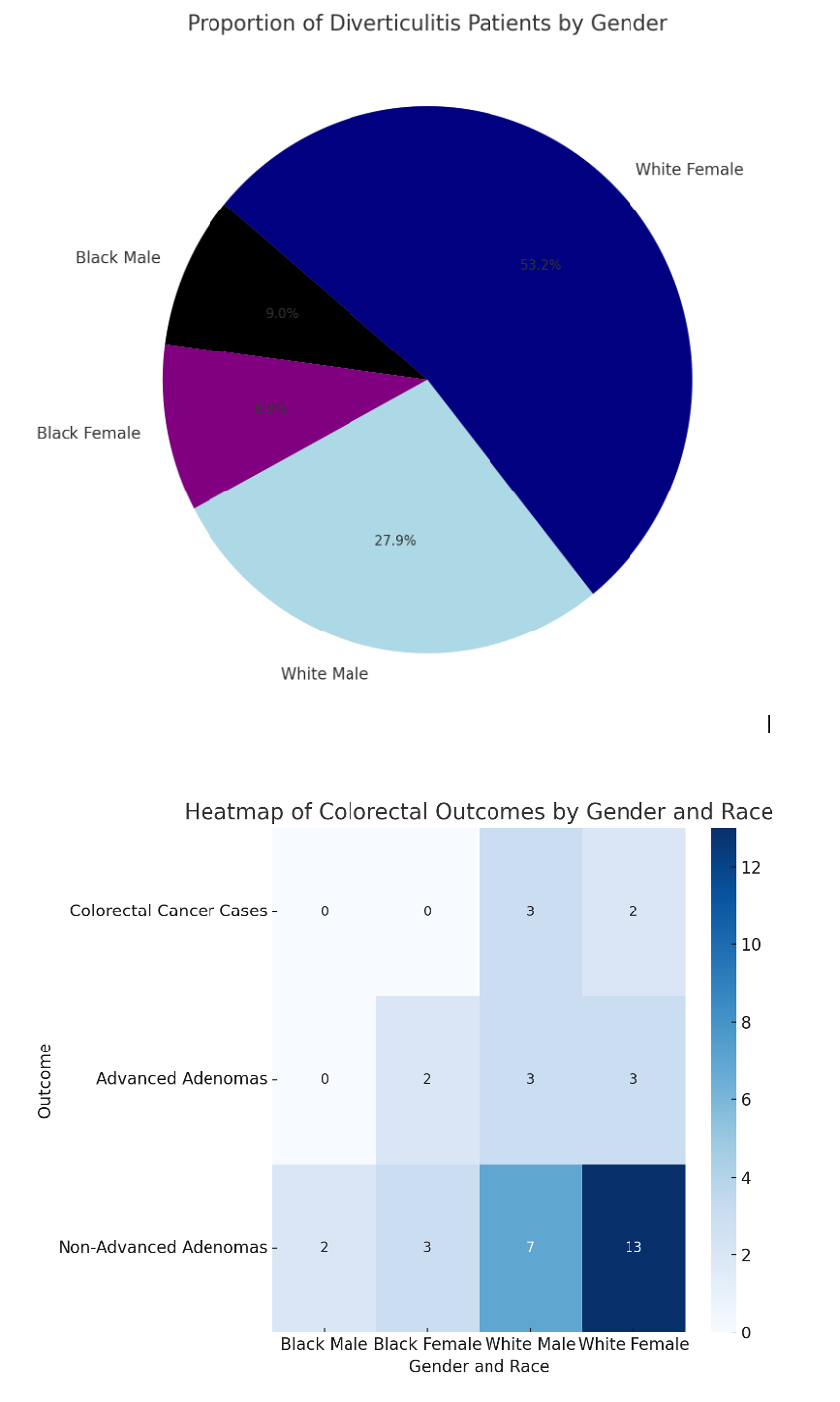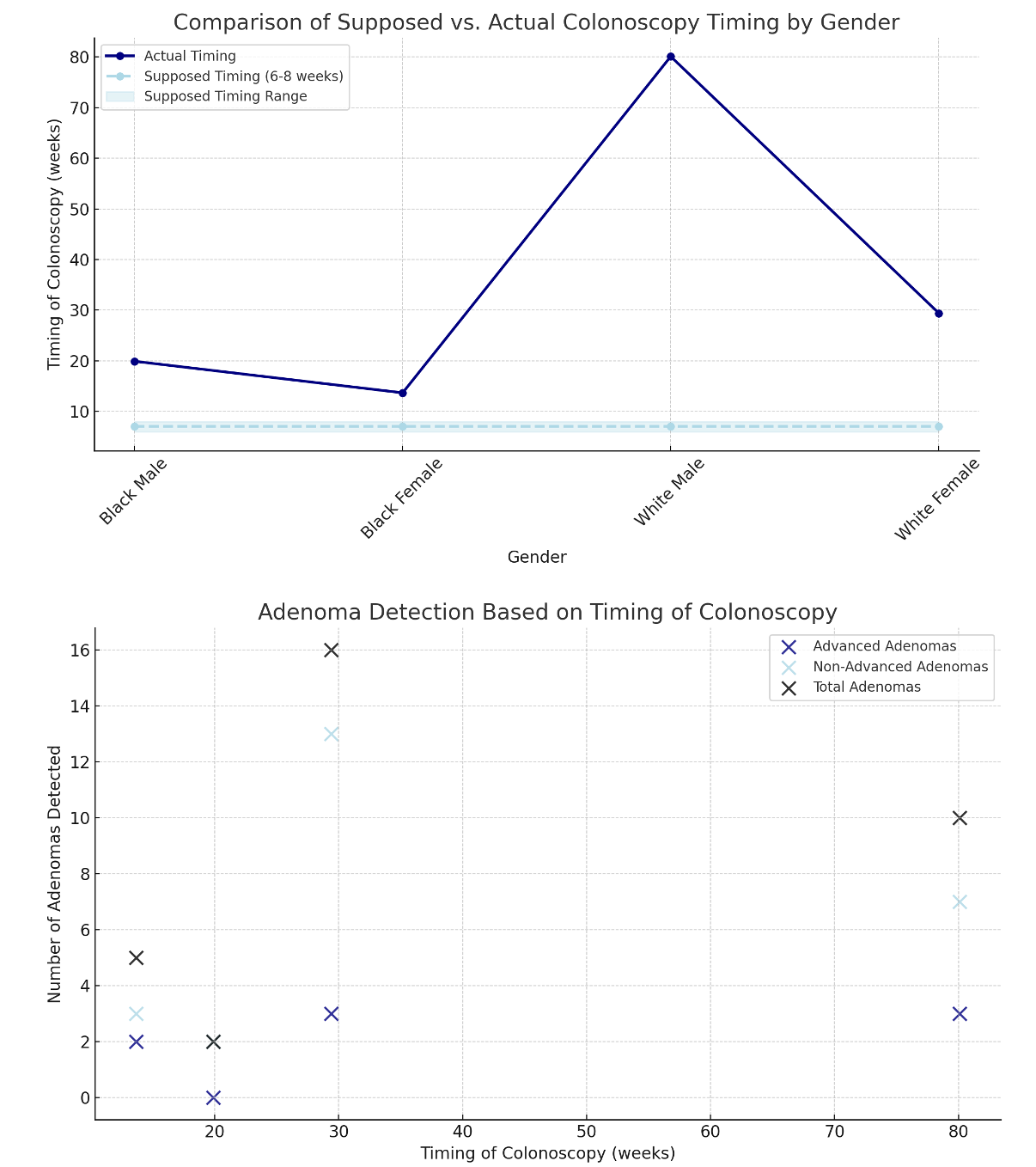Tuesday Poster Session
Category: Colorectal Cancer Prevention
P4760 - Racial and Gender Differences in Adenoma Detection in Routine Colonoscopy After Acute Diverticulitis
Tuesday, October 28, 2025
10:30 AM - 4:00 PM PDT
Location: Exhibit Hall

Jonathan Ghobrial, MD
Allegheny Health Network Medicine Institute
Pittsburgh, PA
Presenting Author(s)
Jonathan Ghobrial, MD1, Kojo-Frimpong B. Awuah, MD2, Somtochukwu Onwuzo, MD3, Marissa Gorvet, DO1, Hany Habib, MD1, Kaitlyn Gernhard, DO1, Kriti Dhamija, MD2, Akash Gadani, MD3
1Allegheny Health Network Medicine Institute, Pittsburgh, PA; 2Allegheny Health Network, Pittsburgh, PA; 3Allegheny Center for Digestive Health, Pittsburgh, PA
Introduction: Colonic diverticulitis occurs when colonic outpouchings (diverticula) become inflamed. Symptoms include fever, abdominal pain, and hematochezia. Guidelines recommend follow-up colonoscopy 6–8 weeks post-acute diverticulitis to rule out colorectal cancer (CRC). Data on follow-up outcomes by race and gender remain limited. This study evaluates differences in adenoma detection by race and gender to reassess risk stratification in vulnerable populations.
Methods: A retrospective cohort study reviewed clinical data from 550 patients treated at a tertiary center for acute diverticulitis between Jan 1, 2021 and Jul 31, 2024. Adults (≥18 years) who had post-diverticulitis colonoscopy or sigmoidoscopy were included. Patients without follow-up endoscopy or with prior CRC unrelated to diverticulitis were excluded. Data collected included demographics, comorbidities, BMI, social/family history, medication use, and colonoscopy findings.
Primary outcomes were detection rates of CRC, advanced adenomas (AA), and non-advanced adenomatous polyps (NAP). AA were defined as ≥1 cm polyps, villous or tubulovillous histology, or dysplasia. Timing of colonoscopy relative to the 6–8 week window was analyzed. Statistical methods were primarily descriptive, including frequencies and proportions.
Results: Of 550 patients, 113 (20.5%) underwent follow-up colonoscopy. Among them: 4.4% had CRC, 6.2% AA, and 23.9% NAP. Breakdown: 10 Black males, 11 Black females, 31 White males, 59 White females, and 2 non-Black/non-White patients. NAP rates: Black males 20%, Black females 27.3%, White males 22.6%, White females 22.0%. AA: Black females 18.2%, White males and females 9.7%, Black males 0%. CRC: White males 9.8%, White females 3.4%.
Discussion: Although diverticulitis is more common in women over 50, CRC detection post-diverticulitis was higher in White males. High AA rates in Black women suggest further investigation is needed. While debate continues over the necessity of follow-up colonoscopy after diverticulitis, more studies are needed to identify high-risk groups for CRC.

Figure: Pie chart showing rates of diverticulitis by Gender and heat map showing outcomes by gender.

Figure: Graph showing average colonoscopy time among different genders and adenoma detection rates based on timing.
Disclosures:
Jonathan Ghobrial indicated no relevant financial relationships.
Kojo-Frimpong B. Awuah indicated no relevant financial relationships.
Somtochukwu Onwuzo indicated no relevant financial relationships.
Marissa Gorvet indicated no relevant financial relationships.
Hany Habib indicated no relevant financial relationships.
Kaitlyn Gernhard indicated no relevant financial relationships.
Kriti Dhamija indicated no relevant financial relationships.
Akash Gadani: Phantom Pharmaceuticals – Speakers Bureau.
Jonathan Ghobrial, MD1, Kojo-Frimpong B. Awuah, MD2, Somtochukwu Onwuzo, MD3, Marissa Gorvet, DO1, Hany Habib, MD1, Kaitlyn Gernhard, DO1, Kriti Dhamija, MD2, Akash Gadani, MD3. P4760 - Racial and Gender Differences in Adenoma Detection in Routine Colonoscopy After Acute Diverticulitis, ACG 2025 Annual Scientific Meeting Abstracts. Phoenix, AZ: American College of Gastroenterology.
1Allegheny Health Network Medicine Institute, Pittsburgh, PA; 2Allegheny Health Network, Pittsburgh, PA; 3Allegheny Center for Digestive Health, Pittsburgh, PA
Introduction: Colonic diverticulitis occurs when colonic outpouchings (diverticula) become inflamed. Symptoms include fever, abdominal pain, and hematochezia. Guidelines recommend follow-up colonoscopy 6–8 weeks post-acute diverticulitis to rule out colorectal cancer (CRC). Data on follow-up outcomes by race and gender remain limited. This study evaluates differences in adenoma detection by race and gender to reassess risk stratification in vulnerable populations.
Methods: A retrospective cohort study reviewed clinical data from 550 patients treated at a tertiary center for acute diverticulitis between Jan 1, 2021 and Jul 31, 2024. Adults (≥18 years) who had post-diverticulitis colonoscopy or sigmoidoscopy were included. Patients without follow-up endoscopy or with prior CRC unrelated to diverticulitis were excluded. Data collected included demographics, comorbidities, BMI, social/family history, medication use, and colonoscopy findings.
Primary outcomes were detection rates of CRC, advanced adenomas (AA), and non-advanced adenomatous polyps (NAP). AA were defined as ≥1 cm polyps, villous or tubulovillous histology, or dysplasia. Timing of colonoscopy relative to the 6–8 week window was analyzed. Statistical methods were primarily descriptive, including frequencies and proportions.
Results: Of 550 patients, 113 (20.5%) underwent follow-up colonoscopy. Among them: 4.4% had CRC, 6.2% AA, and 23.9% NAP. Breakdown: 10 Black males, 11 Black females, 31 White males, 59 White females, and 2 non-Black/non-White patients. NAP rates: Black males 20%, Black females 27.3%, White males 22.6%, White females 22.0%. AA: Black females 18.2%, White males and females 9.7%, Black males 0%. CRC: White males 9.8%, White females 3.4%.
Discussion: Although diverticulitis is more common in women over 50, CRC detection post-diverticulitis was higher in White males. High AA rates in Black women suggest further investigation is needed. While debate continues over the necessity of follow-up colonoscopy after diverticulitis, more studies are needed to identify high-risk groups for CRC.

Figure: Pie chart showing rates of diverticulitis by Gender and heat map showing outcomes by gender.

Figure: Graph showing average colonoscopy time among different genders and adenoma detection rates based on timing.
Disclosures:
Jonathan Ghobrial indicated no relevant financial relationships.
Kojo-Frimpong B. Awuah indicated no relevant financial relationships.
Somtochukwu Onwuzo indicated no relevant financial relationships.
Marissa Gorvet indicated no relevant financial relationships.
Hany Habib indicated no relevant financial relationships.
Kaitlyn Gernhard indicated no relevant financial relationships.
Kriti Dhamija indicated no relevant financial relationships.
Akash Gadani: Phantom Pharmaceuticals – Speakers Bureau.
Jonathan Ghobrial, MD1, Kojo-Frimpong B. Awuah, MD2, Somtochukwu Onwuzo, MD3, Marissa Gorvet, DO1, Hany Habib, MD1, Kaitlyn Gernhard, DO1, Kriti Dhamija, MD2, Akash Gadani, MD3. P4760 - Racial and Gender Differences in Adenoma Detection in Routine Colonoscopy After Acute Diverticulitis, ACG 2025 Annual Scientific Meeting Abstracts. Phoenix, AZ: American College of Gastroenterology.
